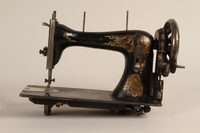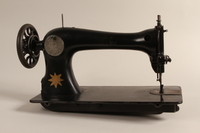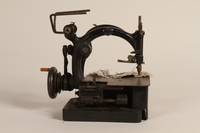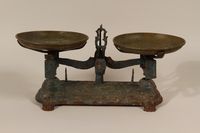Overview
- Brief Narrative
- Treadle sewing machines like this Russian model with Singer sewing table were used by Jewish forced laborers in Łódź Ghetto in German occupied Poland from May 1940 to summer 1944. These mass produced models were inexpensive and very durable. Łódź was occupied by Germany a week after the September 1939 invasion of Poland. It was renamed Litzmannstadt and, in February 1940, the Jewish population, about 160,000 people, was confined to a small sealed off ghetto. All residents had to work and many were forced laborers in ghetto factories. Eventually, nearly 100 factories were in operation. The major ones produced textiles, including uniforms for the German Army. Due to the severe overcrowding and scarce food, disease and starvation were common. The Judenrat [Jewish Council] administered the ghetto for the Germans. Judenrat chairman Mordechai Rumkowski thought hard work and high outputs would preserve the ghetto. But in January 1942, mass deportations to Chelmno killing center began; half the residents were murdered by the end of the year. In summer 1944, Łódź, the last ghetto in Poland, was destroyed and the remaining Jews were sent to Chelmno and Auschwitz-Birkenau killing centers.
- Date
-
manufacture:
after 1917-1950
use: approximately 1917-1945
- Geography
-
manufacture:
Russia
manufacture: United States
- Credit Line
- United States Holocaust Memorial Museum Collection
- Markings
- a. front, gold paint : ГОСШВЕЙМАШИНА [SEWING MACHINE]
a. front, baseplate, engraved : P 3389896
a. front, baseplate, gold paint : Г.Ш.М [G. SH. M.]
a. front right, gold paint : С.С.С.Р. [U.S.S.R.]
a. back, gold paint : ГОСШВЕЙМАШИНА [SEWING MACHINE]
b. base, sides, embossed : THE SINGER MANFG. CO. / TRADEMARK
b. base, center, wrought : SINGER - Contributor
-
Manufacturer:
Singer Sewing Machine Corp.
Physical Details
- Classification
-
Tools and Equipment
- Category
-
Sewing equipment and supplies
- Object Type
-
Sewing machines (lcsh)
- Physical Description
- a. Black painted, cast iron treadle powered sewing machine designed to be stored in a treadle table (b). It has a vertical body on the right with a horizontal arm that extends to the left over a flat rectangular base plate. On top of the arm is a spool pin and at the left end is a rectangular sewing head with a face plate, tension levers, and thread guides. On top of the head are 2 tension rods; on the bottom, a needle and an L shaped presser foot. On the base, below the needle are 2 slotted, sliding plates. Attached to the right end of the machine are a spoked wheel and pulley disc, with an adjustment lever and bobbin winder on the front. Above the pulley is a curved belt guide. On the base underside, below the needle, is a shuttle mount with a bobbin case. There are 2 mounting lugs on the back to attach the machine to a table. The machine has painted gold and bronze floral designs overall. The user controls the motion and speed of the machine by pressing down on the pivoting treadle connected to the sewing machine table (b). This turns a large spoked wheel on the table, which is connected to a smaller spoked wheel and pulley on the machine by the treadle belt. The belt turns the pulley and shifts the interior mechanism, which pushes the needle up and down, pulling 2 threads, top and bottom, to create a lockstitch.
b. Brown, wooden treadle table with black painted, metal, lattice work legs made to store a sewing machine (a). An H cross brace connects the legs. A large spoked wheel is attached to the right side of the brace and a rectangular treadle is attached near the bottom. The table has a flat, rectangular top with a beveled edge and a box shaped body with a sloped bottom. There are 5 rectangular drawers beneath: an open, rectangular space for a shallow drawer, now missing, flanked by 2 sets of stacked rectangular drawers with locks and wooden pulls. Two flat, hinged wooden panels are attached to the top of the table over the box. There are 2 thick, mounting posts for the machine on the inner edge of the top panel. The treadle belt is still attached. - Dimensions
- a: Height: 11.250 inches (28.575 cm) | Width: 16.125 inches (40.958 cm) | Depth: 7.250 inches (18.415 cm)
b: Height: 30.750 inches (78.105 cm) | Width: 35.250 inches (89.535 cm) | Depth: 18.500 inches (46.99 cm) - Materials
- a : cast iron, metal, paint
b : metal, wood, cloth, adhesive, paint
Rights & Restrictions
- Conditions on Access
- No restrictions on access
- Conditions on Use
- No restrictions on use
Keywords & Subjects
Administrative Notes
- Legal Status
- Permanent Collection
- Provenance
- The sewing machine was acquired by the United States Holocaust Memorial Museum in 1990.
- Funding Note
- The cataloging of this artifact has been supported by a grant from the Conference on Jewish Material Claims Against Germany.
- Record last modified:
- 2022-07-28 18:21:32
- This page:
- https://collections.ushmm.org/search/catalog/irn4100
Download & Licensing
In-Person Research
- By Appointment
- Request 21 Days in Advance of Visit
- Plan a Research Visit
- Request to See This Object
Contact Us
Also in Eastern European sewing equipment collection
The collection consists of six sewing machines, treadle tables, and a scale used in Poland before, during, and after World War II.
Date: after 1916-before 1950

Singer style treadle sewing machine table of the type used in Łódź Ghetto
Object
Treadle sewing machines like this Singer model were used by Jewish forced laborers in Łódź Ghetto in German occupied Poland from May 1940 to summer 1944. This mass produced machine was very durable and affordable. Łódź was occupied by Germany a week after the September 1939 invasion of Poland. It was renamed Litzmannstadt and, in February 1940, the Jewish population, about 160,000 people, was confined to a small sealed off ghetto. All residents had to work and many were forced laborers in ghetto factories. Eventually, nearly 100 factories were in operation. The major ones produced textiles, including uniforms for the German Army. Due to the severe overcrowding and scarce food, disease and starvation were common. The Judenrat [Jewish Council] administered the ghetto for the Germans. Judenrat chairman Mordechai Rumkowski thought hard work and high outputs would preserve the ghetto. But in January 1942, mass deportations to Chelmno killing center began; half the residents were murdered by the end of the year. In summer 1944, Łódź, the last ghetto in Poland, was destroyed and the remaining Jews were sent to Chelmno and Auschwitz-Birkenau killing centers.

Treadle sewing machine with painted star of the type used in Łódź Ghetto
Object
Treadle sewing machines like this ladies' home model sewing machine were used by Jewish forced laborers in Łódź Ghetto in German occupied Poland from May 1940 to summer 1944. This mass produced machine was very durable and affordable. Łódź was occupied by Germany a week after the September 1939 invasion of Poland. It was renamed Litzmannstadt and, in February 1940, the Jewish population, about 160,000 people, was confined to a small sealed off ghetto. All residents had to work and many were forced laborers in ghetto factories. Eventually, nearly 100 factories were in operation. The major ones produced textiles, including uniforms for the German Army. Due to the severe overcrowding and scarce food, disease and starvation were common. The Judenrat [Jewish Council] administered the ghetto for the Germans. Judenrat chairman Mordechai Rumkowski thought hard work and high outputs would preserve the ghetto. But in January 1942, mass deportations to Chelmno killing center began; half the residents were murdered by the end of the year. In summer 1944, Łódź, the last ghetto in Poland, was destroyed and the remaining Jews were sent to Chelmno and Auschwitz-Birkenau killing centers.

Chain stitch sewing machine of the type used in Łódź Ghetto
Object
Chain stitch treadle sewing machines like this were used by Jewish forced laborers in Łódź Ghetto in German occupied Poland from May 1940 to summer 1944. Łódź was occupied by Germany a week after the September 1939 invasion of Poland. It was renamed Litzmannstadt and, in February 1940, the Jewish population, about 160,000 people, was confined to a small sealed off ghetto. All residents had to work and many were forced laborers in ghetto factories. Eventually, nearly 100 factories were in operation. The major ones produced textiles, including uniforms for the German Army. Due to the severe overcrowding and scarce food, disease and starvation were common. The Judenrat [Jewish Council] administered the ghetto for the Germans. Judenrat chairman Mordechai Rumkowski thought hard work and high outputs would preserve the ghetto. But in January 1942, mass deportations to Chelmno killing center began; half the residents were murdered by the end of the year. In summer 1944, Łódź, the last ghetto in Poland, was destroyed and the remaining Jews were sent to Chelmno and Auschwitz-Birkenau killing centers.

Iron shop store hand scale with two copper trays
Object
Iron measuring scale with two copper trays of the type possibly used in Łódź Ghetto in German occupied Poland from May 1940 to summer 1944. Łódź was occupied by Germany a week after the September 1939 invasion of Poland. It was renamed Litzmannstadt and, in February 1940, the Jewish population, about 160,000 people, was confined to a small sealed off ghetto. All residents had to work and many were forced laborers in ghetto factories. Eventually, nearly 100 factories were in operation. The major ones produced textiles, including uniforms for the German Army. Due to the severe overcrowding and scarce food, disease and starvation were common. The Judenrat [Jewish Council] administered the ghetto for the Germans. Judenrat chairman Mordechai Rumkowski thought hard work and high outputs would preserve the ghetto. But in January 1942, mass deportations to Chelmno killing center began; half the residents were murdered by the end of the year. In summer 1944, Łódź, the last ghetto in Poland, was destroyed and the remaining Jews were sent to Chelmno and Auschwitz-Birkenau killing centers.
Treadle sewing machine table of the type used in Łódź Ghetto
Object
Wooden and cast iron sewing machine table top and base of the type used by Jewish forced laborers in Łódź Ghetto in German occupied Poland from May 1940 to summer 1944. Łódź was occupied by Germany a week after the September 1939 invasion of Poland. It was renamed Litzmannstadt and, in February 1940, the Jewish population, about 160,000 people, was confined to a small sealed off ghetto. All residents had to work and many were forced laborers in ghetto factories. Eventually, nearly 100 factories were in operation. The major ones produced textiles, including uniforms for the German Army. Due to the severe overcrowding and scarce food, disease and starvation were common. The Judenrat [Jewish Council] administered the ghetto for the Germans. Judenrat chairman Mordechai Rumkowski thought hard work and high outputs would preserve the ghetto. But in January 1942, mass deportations to Chelmno killing center began; half the residents were murdered by the end of the year. In summer 1944, Łódź, the last ghetto in Poland, was destroyed and the remaining Jews were sent to Chelmno and Auschwitz-Birkenau killing centers.
Pfaff industrial sewing machine with treadle of the type used in Łódź Ghetto
Object
Treadle sewing machines like this Pfaff industrial model were used by Jewish forced laborers in Łódź Ghetto in German occupied Poland from May 1940 to summer 1944. This mass produced machine was very durable and affordable. Łódź was occupied by Germany a week after the September 1939 invasion of Poland. It was renamed Litzmannstadt and, in February 1940, the Jewish population, about 160,000 people, was confined to a small sealed off ghetto. All residents had to work and many were forced laborers in ghetto factories. Eventually, nearly 100 factories were in operation. The major ones produced textiles, including uniforms for the German Army. Due to the severe overcrowding and scarce food, disease and starvation were common. The Judenrat [Jewish Council] administered the ghetto for the Germans. Judenrat chairman Mordechai Rumkowski thought hard work and high outputs would preserve the ghetto. But in January 1942, mass deportations to Chelmno killing center began; half the residents were murdered by the end of the year. In summer 1944, Łódź, the last ghetto in Poland, was destroyed and the remaining Jews were sent to Chelmno and Auschwitz-Birkenau killing centers.
Singer treadle sewing machine table of the type used in Łódź Ghetto
Object
Singer iron and wood sewing machine table of the type used in Łódź Ghetto in German occupied Poland from May 1940 to summer 1944. Łódź was occupied by Germany a week after the September 1939 invasion of Poland. It was renamed Litzmannstadt and, in February 1940, the Jewish population, about 160,000 people, was confined to a small sealed off ghetto. All residents had to work and many were forced laborers in ghetto factories. Eventually, nearly 100 factories were in operation. The major ones produced textiles, including uniforms for the German Army. Due to the severe overcrowding and scarce food, disease and starvation were common. The Judenrat [Jewish Council] administered the ghetto for the Germans. Judenrat chairman Mordechai Rumkowski thought hard work and high outputs would preserve the ghetto. But in January 1942, mass deportations to Chelmno killing center began; half the residents were murdered by the end of the year. In summer 1944, Łódź, the last ghetto in Poland, was destroyed and the remaining Jews were sent to Chelmno and Auschwitz-Birkenau killing centers.



